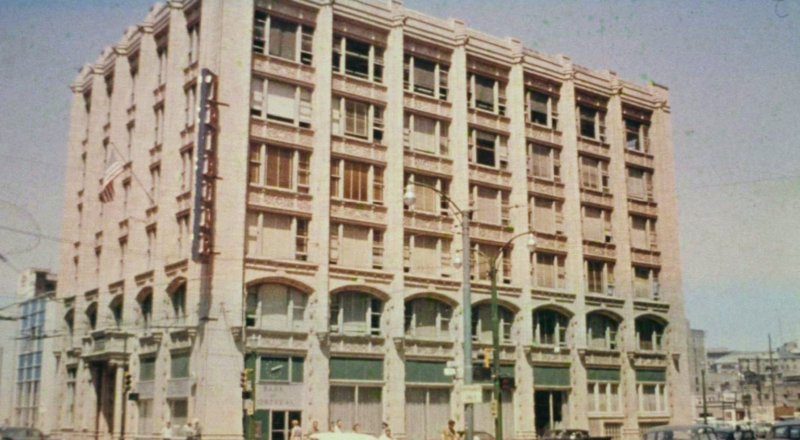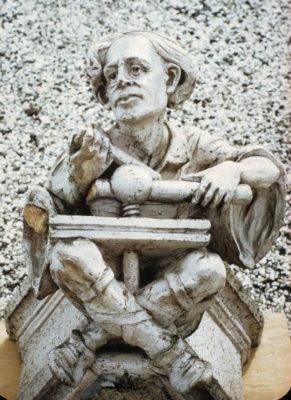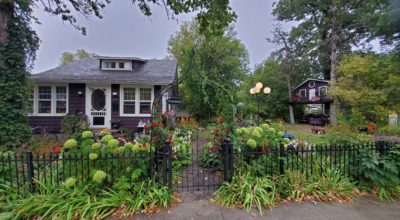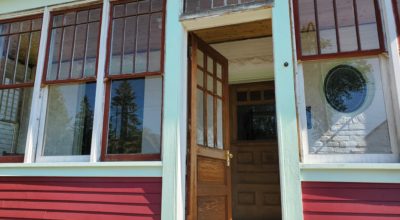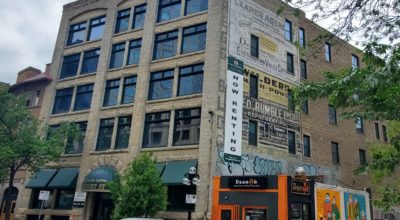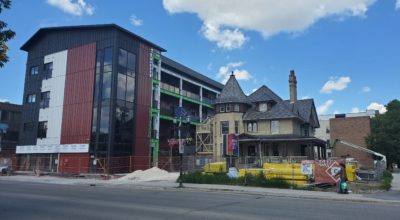
/ Blog
March 23, 2024
Hot Off The Press! The Tribune Building
Around the turn of the 20th century, Winnipeg was a booming young city on the prairies with lots of news to share and an ever growing population to share it with. Dozens of newspapers started up in the city, trying to capitalize on the prosperity and tell their stories, but few would leave a lasting impression. Surprisingly, one of the few enduring publications, endeared to the community, has all but vanished without a trace. The Winnipeg Tribune was in print for 90 years, calling several locations throughout the downtown home. Today, all of its buildings are demolished. But memories of the iconic newspaper and artifacts live on, filling some of the voids left behind when the presses went silent.
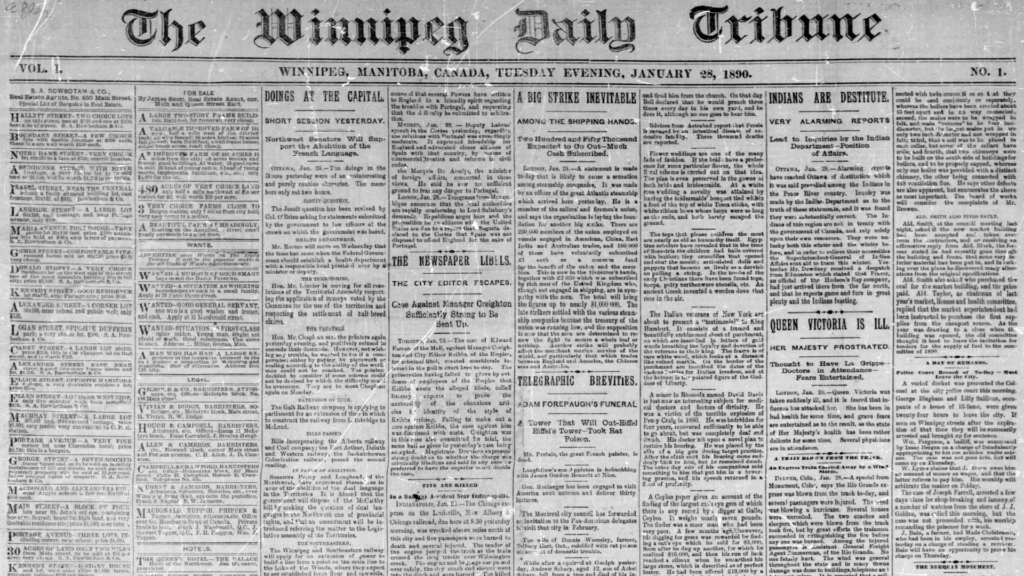
The front page of the first issue of the Winnipeg Tribune. It was published on January 28th, 1890.
Source: The Winnipeg Daily Tribune (University of Manitoba Libraries)
The first newspaper printed in the community that would someday become Winnipeg was the Nor’Wester. It was started by William Coldwell and William Buckingham, two young men with experience as reporters in Toronto. The arrival of the newspaper was greeted with excitement and trepidation; it spurred on progress but locals worried that outsiders would harshly judge their youthful, unrefined town. After some struggles with frozen newsprint, the first issue of the Nor’Wester was published on December 28th, 1859, costing just a sixpence per copy. The newspaper was short lived, shut down by Louis Riel during the Red River Resistance due the opinions it printed and its perceived influence. The final issue of the Nor’Wester was published on November 23rd, 1869.
This was not the end of the newspaper, instead it was just the beginning. A slew of new newspapers would take the place vacated by the Nor’Wester, with the period between 1870 and 1883 seeing almost 20 new newspapers start printing in Winnipeg. Few would stand the test of time, other than the Manitoba Free Press. Established in 1875, the newspaper now known as the Winnipeg Free Press is still read by over 400,000 people every week.
One of the newspapers from 19th century Winnipeg that did not last was the Sun (not the same Winnipeg Sun that is in print today!). After it was absorbed by the Free Press, the old location and equipment from the Sun were purchased by L.R. Richardson and D.L. McIntyre. The two set about starting yet another new newspaper in the city, this one called the Winnipeg Tribune. The first issue was published on January 28th, 1890. Despite old equipment and meager beginnings, the newspaper would thrive thanks to Winnipeg’s booming economy, becoming a serious competitor of the Free Press over time.
The Winnipeg Tribune started operations in the Robertson Block at the north east corner of Main Street and Bannatyne Avenue, where the Imperial Bank of Canada Building at 441 Main Street is located today. From there the newspaper moved into the Grand Theatre on the north side of McDermot Avenue, next door to the current Bate Block at 221 McDermot Avenue. The Grand Theatre, when it became known as the Tribune Block, was part of Winnipeg’s “Newspaper Row”. Located on the west side of Main Street, Newspaper Row was established by the arrival of the Free Press in the Bate Block on McDermot Avenue in 1882. All of the city’s major newspapers: the Winnipeg Daily Times, the Winnipeg Telegram and the Winnipeg Tribune, would join the Free Press on McDermot Avenue. Newspaper Row came to an end in 1920 and while some of the buildings associated with it still stand, the Tribune Block has been replaced with a surface parking lot.
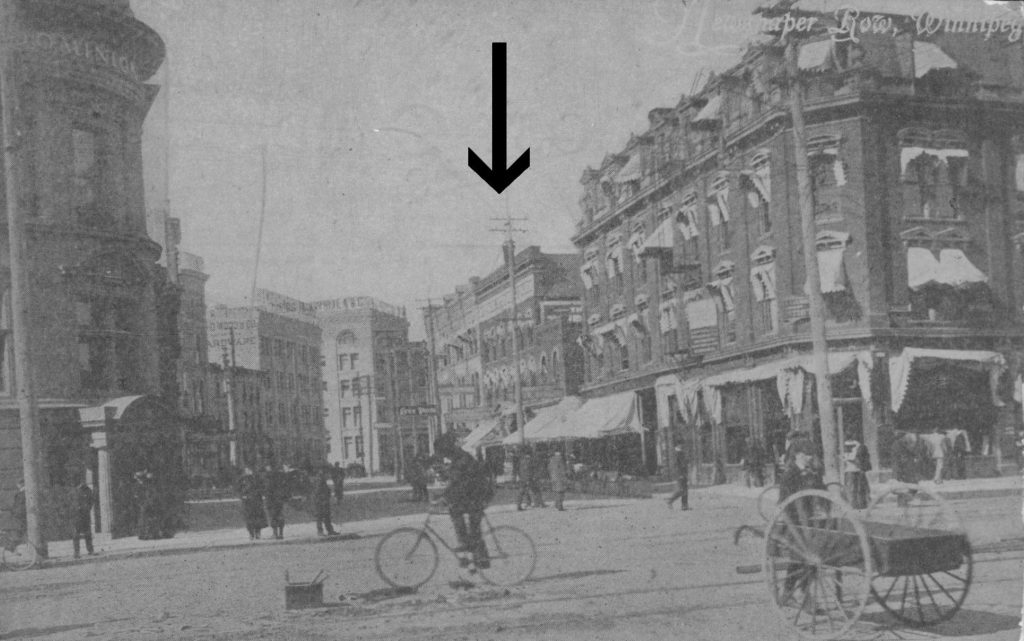
McDermot Avenue extending west from Main Street was known as “Newspaper Row”. Seen here some time between 1901 and 1905, the Winnipeg Telegram was on the left, while the Free Press and Winnipeg Tribune (indicated by the arrow) where on the right.
Source: Martin Berman Postcard Collection (Winnipeg Public Library)
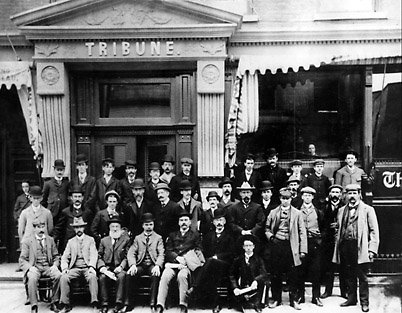
Staff outside the Tribune Block on McDermot Avenue in 1910.
Source: Archives of Manitoba (Virtual Heritage Winnipeg)
In 1912, the Winnipeg Tribune purchased a property at 257 Smith Street for a new building. Designed by John D. Atchison, construction on the Tribune Building began in 1913. Although it was envisioned to be ten storeys tall, the final building only reached up six storeys when completed. Behind a cast iron revolving door on Smith Street the building featured fine finishes in oak, marble and terrazzo. The brand new printing press, capable of producing 32,00 papers an hour, was switched on in January 1914.
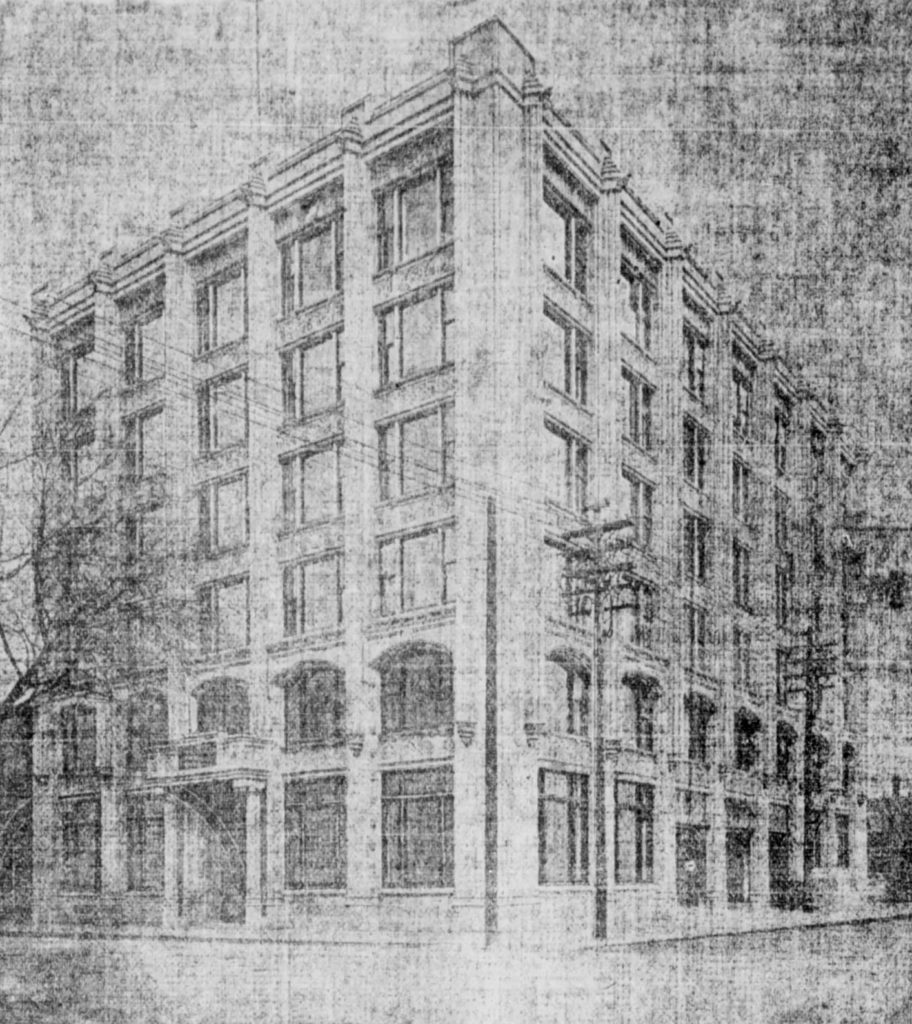
The Tribune Building at 257 Smith Street shortly after opening.
Source: The Winnipeg Tribune – March 7, 1914, page 32
The Tribune Building was designed in the Chicago Style, with large windows set regularly in a marble and terracotta facade. The facade was decorated with Gothic Revival ornamentation: 14 heads projecting from the columns between the first and second floors while 14 gargoyles peered down from the roofline. The gargoyle’s designs were six repeated figures representing different newspaper jobs: city editor (holding scissors and a sheet of paper), printer (holding an antiquated printing press), fish story teller (holding a fish), reporter, proofreader, newsboy and member of the public. Dressed in medieval clothing, the gargoyles were a lighthearted and mischievous addition to the handsome building. It has been speculated that the heads or gargoyles were modeled after senior staff of the newspaper or prominent Winnipeg citizens.
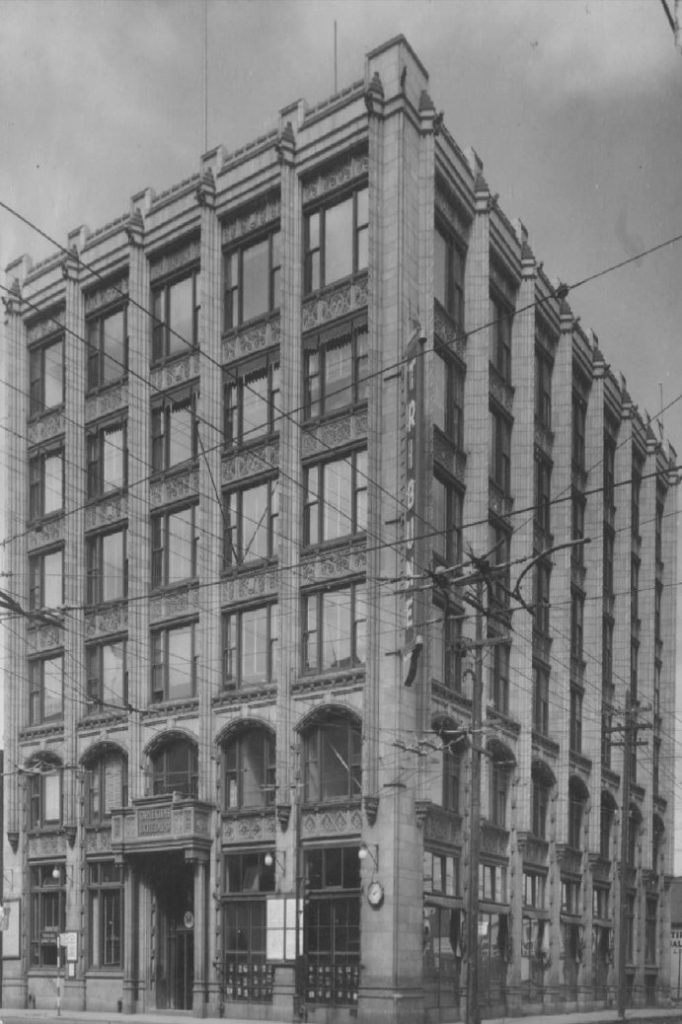
An undated photo of the Tribune Building at 257 Smith Street.
Source: Winnipeg Building Index (University of Manitoba Libraries)
Conflicting stories are told about the heads and gargoyles being removed from the facade of the Tribune Building in 1969. Some say it was because they were at risk of falling off the building, crashing down on unsuspecting pedestrians. The jackhammers needed to remove them would beg to disagree. Others say they were removed because the building was being updated, and the curious faces did not fit the sleek new modern aesthetic. Gifted or sold to people working at or connected to the newspaper, the creatures are almost all in private collections today, with the exception of two that are at the Manitoba Museum. Concrete was used to fill the voids on the Tribune Building’s facade where the grotesque characters were removed.
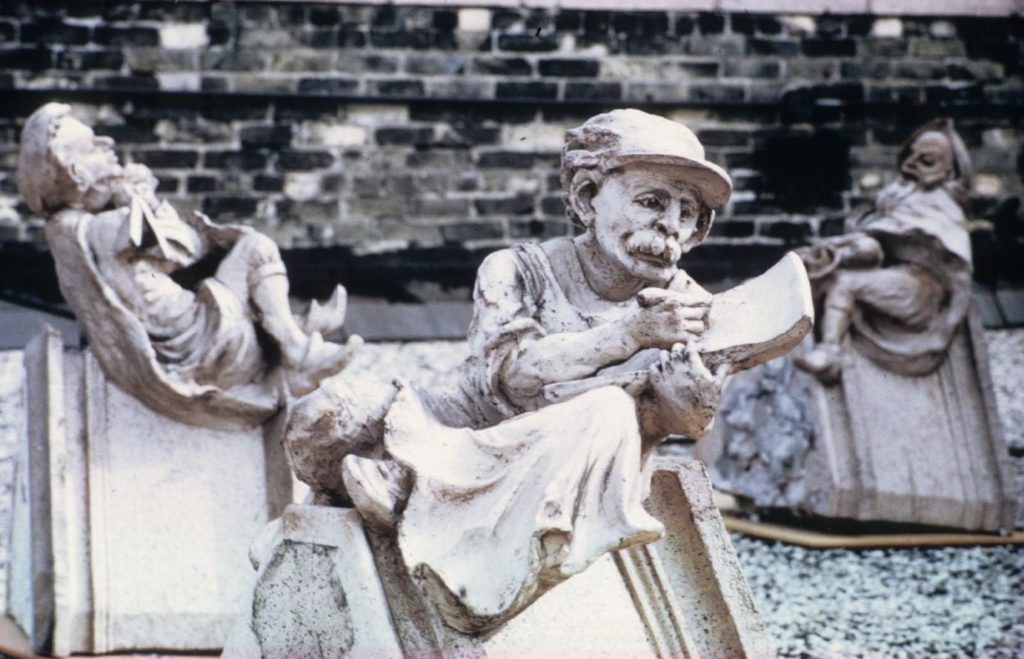
Gargoyles from the Tribune Building at 257 Smith Street.
Source: Winnipeg Building Index (University of Manitoba Libraries)
In 1920, the Winnipeg Tribune merged with the Winnipeg Telegram and continued to prosper. In 1965, the newspaper celebrated its 75th anniversary with all kinds of festivities. The April 6th issue was made to look exactly like the very first issue printed in 1890, although the articles covered slightly different stories. Memorabilia, such as coasters and matchbooks were printed and handed out. At the time, no one would have guessed at that the newspaper which had outlasted so many of its competitors would come to a jarring and unceremonious end.
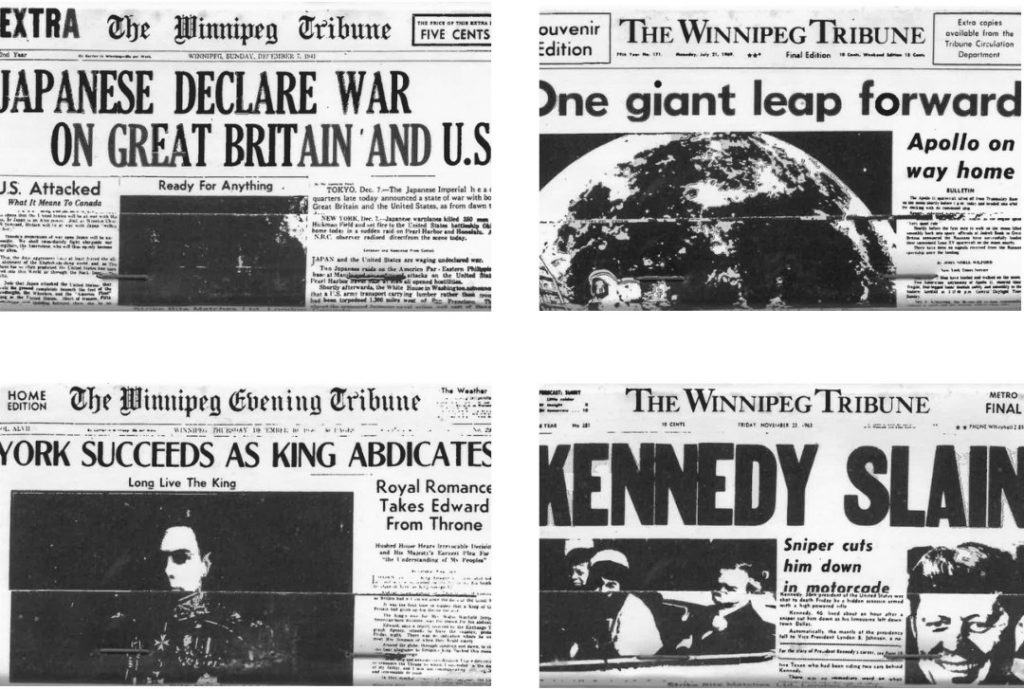
Commemorative matchbooks from the Winnipeg Tribune’s 75th anniversary, donated to Heritage Winnipeg by Wayne Johnson in honour of his late uncle George Townsend, former Chief Controller of the newspaper.
Source: Heritage Winnipeg
On the morning of August 27th, 1980, the presses at the Tribune Building abruptly stopped printing as the final issue was delivered. By the end of the day 375 people had lost their jobs and Winnipeg lost a newspaper, all due to corporate downsizing and negotiations between competitors. The final headline of the newspaper read “It’s been 90 great years!” along with a note of thanks to the readers, advertisers and carriers. It was a sudden and unexpected end that no one had seen coming. The shocking news left Winnipeg with only one daily English language newspaper, the Free Press, which has continued to publish in a changing media landscape. Demolition of the Tribune Building at 257 Smith Street started in October 1983, completed in a month. The site became a surface parking lot, which remains an ugly corner in Winnipeg’s downtown to this day. Fortunately, the entire archive of the Winnipeg Tribune is now available for free online, purchased by the University of Manitoba for the bargain price of $1.
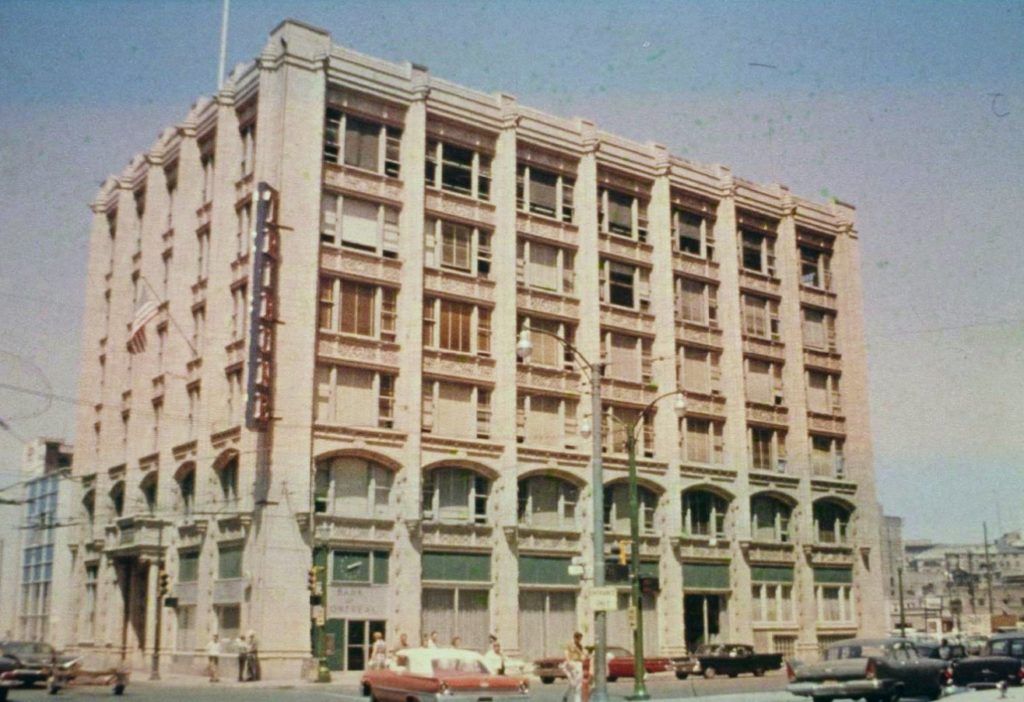
An undated photo of the Tribune Building at 257 Smith Street.
Source: Winnipeg Building Index (University of Manitoba Libraries)
The Winnipeg Tribune was the kind of paper that everyone cheered for, an underdog that printed local stories by beloved journalists. Its buildings told the story of Winnipeg’s expansion as a city, starting out on Main Street near City Hall, moving to Newspaper Row in the Exchange District, and then migrating down Portage Avenue when the commercial heart of the city shifted. The Tribune Building could have been a wonderful addition to our downtown today. Beautifully designed on a human scale and with large windows, it would have been an excellent candidate for a mixed use redevelopment in a city in need of more housing. Instead the reality is as bleak as the concrete that was once used to replace the charming gargoyles, a soulless parking lot that does nothing to build community. It is a reminder that not everything that is old should be disposed of – in the future it may become a valued treasure. Decorations once stripped from the facade of the Tribune Building are now museum worthy, its archive once sold for a dollar is now an important record of Winnipeg’s past. Let us learn and do better, for once an historic building is gone it is lost forever, along with all its history, character and potential to serve its community. And we do not need any more parking lots!
THANK YOU TO THE SPONSOR OF THIS BLOG POST:

Written by Heritage Winnipeg.
SOURCES:
Architectural Styles | Heritage Manitoba
THE CLOSURE OF THE WINNIPEG TRIBUNE | George Siamandas - The Winnipeg Time Machine - April 12, 2009
From 1980: When daily papers in Winnipeg and Ottawa folded | CBC Archives - August 30, 2018
Tribune Gargoyle 1914 | A Museum Called Manitoba
Winnipeg Free Press – Partners in Progress | Winnipeg Free Press
Winnipeg Grotesque | Dr. Roland Sawatzky - Manitoba Museum - October 20, 2022
Winnipeg Tribune fonds | University of Manitoba Libraries





